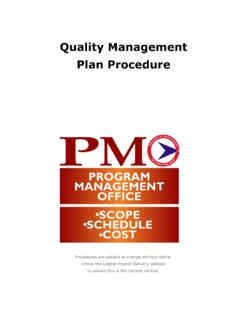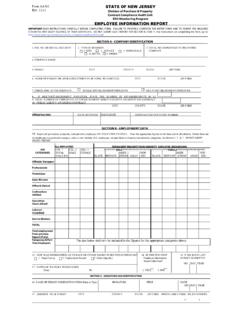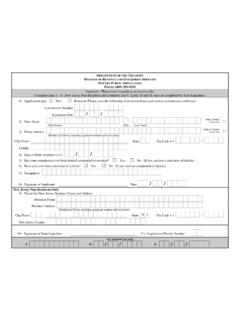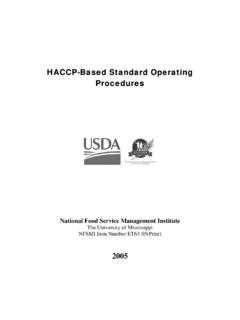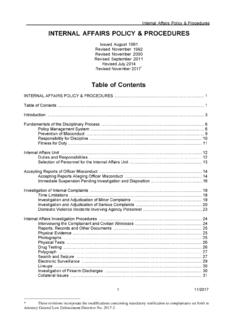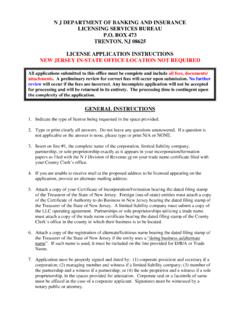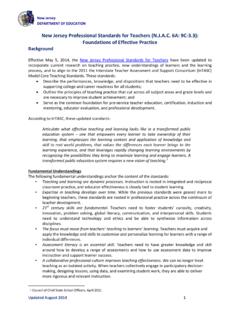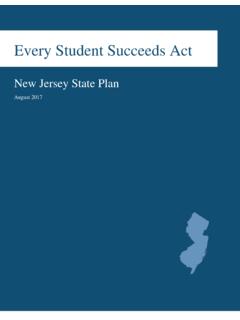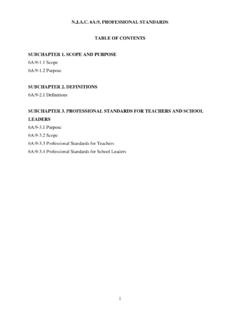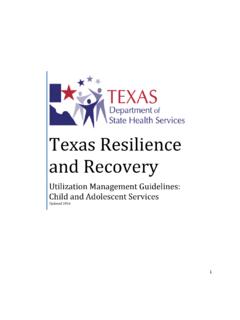Transcription of Step by Step - State
1 wellness In Eight dimensions Peggy Swarbrick and Jay Yudof February 2014 Collaborative Support Programs of NJ, Inc. - 2 - - 3 - wellness wellness involves being aware of ourselves as whole people, including a sense of balance and comfort. It is a sense that things are going well for us today, and can continue to go well for us tomorrow. It is a sense that we have meaningful relationships and a sense of meaning and purpose. Although we may have setbacks, or experience stress, we are resilient and we have strength, material resources, and the support of others to survive and thrive. Stress, addictions, illness, and traumatic experiences impact wellness and balance. At the Institute, we believe that helping people improve their personal wellness , as they define it, is critical. wellness incorporates all of the eight dimensions shown on the cover and back of this booklet. Each dimension of wellness can affect our overall quality of life, because wellness directly relates to how long we live (longevity) and how well we live (quality of life).
2 When we look at the eight-dimension model , our attention is drawn to the idea that all eight dimensions are connected. We all know how much they are connected in our lives. When we feel financially stressed ( , increasing debt), we experience emotional stress (anxiety), sometimes leading to physical problems (illness), less effectiveness at work (occupational), and maybe even questioning our own meaning and purpose in life (spiritual). When we are not working (occupational), we lose some of our opportunities to interact with others (social), cannot get the quality foods and medical care we need to stay well (physical), and may need to move to a place that feels less safe and secure (environmental). Stress, addiction, trauma, disappointment, and loss can impact our wellness and the balance in our lives. It seems important to balance work with play and rest, to balance time out for recuperation and recovery with living our lives fully and productively, and to balance the desire for rapid change with the known effectiveness of slow changes to build good habits.
3 - 4 - Habits are key for wellness . Our habits affect what we do, how we feel, how we work, how we fuel our minds and bodies and how we spend or save money. Habits become ingrained, and we have to work consciously to maintain or establish good habits that contribute to our wellness , our valued roles, and our personal goals. Some habits (excessive alcohol, harmful drugs or chemicals, consumption of energy drinks, sugar and fat laden foods) can have immediate or long term negative effects on physical, mental, and social well-being. Another part of wellness is our valued roles such as friend, worker, volunteer, student, colleague, parent, spouse, and community member. These roles provide an identity, drive our daily activities, and ignite our passions. wellness involves a sense of empowerment. Each day we wake up we can make choices. Empowerment goes hand-in-hand with taking personal responsibility for our day to day choices and our lives.
4 We hope this guide will help you think about your own wellness what you already do now (your daily routines, habits, and valued life roles and activities), what else you can do or can learn to do, and what type of supports you need to focus on your wellness and balance. One of the things many people find helpful is to look at their own wellness in each dimension. For each of the eight dimensions that follow, record your strengths and your thoughts about areas you may want to change or improve. This wellness booklet can offer some insights to determine things you are doing well and things you may want to start or stop doing. Please use this booklet yourself and consider sharing with co-workers or support group members so you can review, plan, and grow together. We hope this is helpful. We wish you a successful wellness journey! Selected items in this booklet were inspired by or adapted from - 5 - wellness is not the absence of disease, illness, and stress but the presence1 of: Purpose in life Active involvement in satisfying work and play Joyful relationships A healthy body and living environment Happiness wellness is a conscious, deliberate process that requires being aware of and making choices for a more satisfying A wellness lifestyle includes a self-defined balance of health habits such as sleep and rest, eating well, productivity, participation in meaningful activity, and contact with wellness is multi-dimensional: physical, spiritual, social, emotional, intellectual, occupational, environmental, and financial.
5 1 Dunn, H. L. (1961). High-level wellness . Arlington, VA: Beatty Press. 2 Swarbrick, M. (2006). A wellness approach. Psychiatric Rehabilitation Journal, 29(4), 311- 314. 3 Swarbrick, M. (March 1997). A wellness model for clients. Mental Health Special Interest Section Quarterly, 20, 1-4. - 6 - Physical wellness involves the maintenance of a healthy body, good physical health habits, good nutrition and exercise, and obtaining appropriate health care. Strengths These are the things I do well my daily routines, habits, and valued life activities that build and maintain my physical wellness : _____ _____ _____ _____ _____ Physical wellness Self-Assessment I almost always do this = 2 points Sometimes/occasionally = 1 point I very seldom do this = 0 points 1. ___ I exercise aerobically (vigorous, continuous exercise) for 20 to 30 minutes at least three times per week. 2. ___ I eat fresh fruits, vegetables, and whole grains every day.
6 3. ___ I avoid tobacco products. 4. ___ I wear a seat belt while riding in or driving a car. 5. ___ I avoid drinking caffeinated and sugary beverages. 6. ___ I get an adequate amount of sleep (7-9 hours/night). 7. ___ I keep up with my annual physical, dental checkups, immunizations, and self-exams. 8. ___ I maintain a reasonable weight for my age and height. 9. ___ I brush my teeth at least twice daily, and floss at least once daily. 10. ___ I use stress management techniques that help me to stay calm and relaxed. My Score - 7 - Physical wellness - things I would like to do - 8 - Intellectual wellness involves lifelong learning, application of knowledge learned, and sharing knowledge. Strengths These are the things I do well my daily routines, habits, and valued life activities that build and maintain my intellectual wellness : _____ _____ _____ _____ _____ Intellectual wellness Self-Assessment I almost always do this = 2 points Sometimes/occasionally = 1 point I very seldom do this = 0 points 1.
7 ___ I make an effort to learn new things. 2. ___ I try to keep on top of current affairs locally, nationally, and internationally. 3. ___ I listen to lectures, plays, and musical performances in person or online. 4. ___ I do creative and stimulating mental activities/games. 5. ___ I read daily, whether that be the newspaper, the internet, magazines, or books from my local bookstore or library. 6. ___ I practice something every week to improve my skills and use my gifts, such as crafts, cooking, music, or sports. 7. ___ I try to see more than one side of an issue, especially for things that are controversial. 8. ___ I engage in intellectual discussions. 9. ___ I look up things that I don t know. 10. ___ I ask questions to learn from others. My Score - 9 - Intellectual wellness - things I would like to do - 10 - Environmental wellness involves being and feeling physically safe, in safe and clean surroundings, and being able to access clean air, food, and water.
8 Includes both our micro-environment (the places where we live, learn, work, etc.) and our macro-environment (our communities, country, and whole planet). Strengths These are the things I do well my daily routines, habits, and valued life activities that build and maintain my environmental wellness : _____ _____ _____ _____ _____ Environmental wellness Self-Assessment I almost always do this = 2 points Sometimes/occasionally = 1 point I very seldom do this = 0 points 1. ___ I regularly clean my living and work environment. 2. ___ I make maximal use of natural light, fresh air, and live plants. 3. ___ I discard garbage regularly, clean spoiled foods out of the refrigerator, and stay on top of any pet odors. 4. ___ I tidy my home and work spaces in order to prevent clutter and stay organized. 5. ___ I conserve energy (fuel, electricity, water, etc.) in my home, my car, and elsewhere. 6. ___ I recycle (glass, paper, plastic, etc.)
9 7. ___ I do not litter. 8. ___ I purchase recycled items when possible. 9. ___ I set aside time to enjoy nature. 10. ___ I set aside time to reflect and/or practice mindfulness. My Score - 11 - Environmental wellness - things I would like to do - 12 - Spiritual wellness involves having meaning and purpose and a sense of balance and peace. Strengths These are the things I do well my daily routines, habits, and valued life activities that build and maintain my spiritual wellness : _____ _____ _____ _____ _____ Spiritual wellness Self-Assessment I almost always do this = 2 points Sometimes/occasionally = 1 point I very seldom do this = 0 points 1. ___ I can name my own personal values and describe my beliefs about life. 2. ___ I make conscious choices about my daily actions based on my personal values. 3. ___ When I get depressed or frustrated, I draw on my beliefs and values to give me direction. 4. ___ I use prayer, meditation, and/or quiet personal reflection regularly in my life.
10 5. ___ Life is meaningful for me, and I feel a purpose in life. 6. ___ I try to learn about others' beliefs and values, especially those that different from my own. 7. ___ I have a strong sense of optimism and faith in the future. 8. ___ I use my thoughts and attitudes in life-affirming ways. 9. ___ I appreciate the natural forces that exist in the universe. 10. ___ I feel gratitude for the good things in my life. My Score - 13 - Spiritual wellness - things I would like to do - 14 - Social wellness involves having relationships with friends, family, and the community, and having an interest in and concern for the needs of others and humankind. Strengths These are the things I do well my daily routines, habits, and valued life activities that build and maintain my social wellness : _____ _____ _____ _____ _____ Social wellness Self-Assessment I almost always do this = 2 points Sometimes/occasionally = 1 point I very seldom do this = 0 points 1.
